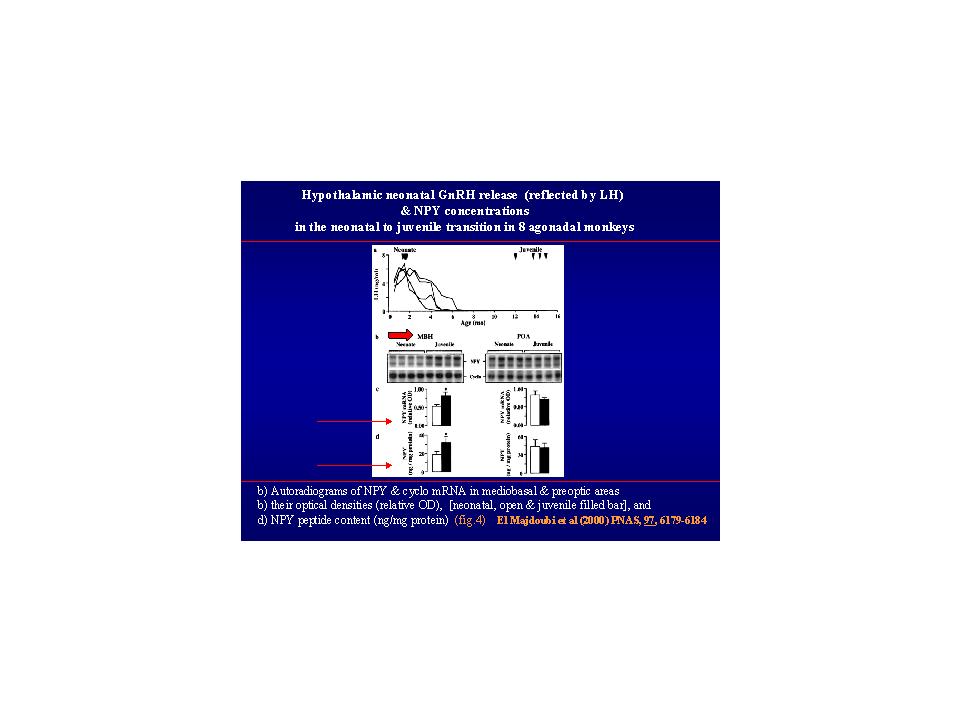|
OADES, R. D.,
Neuropeptide Y: a contribution to the etiology of
symptoms, delayed development and gender differences in ADHD ? 11th
Eunethydis Meeting: Neuropsychobiology of hyperkinesis, (24-26 Nov.
2000) Munich, Germany
Introduction:
Can a consideration of the distribution,
function and development of Neuropeptide Y (NPY) in the brain
offer an insight into, a) symptom
onset in 5-7y-olds, problems maximising 8-12y, and attenuating thereafter;
b) throw light on the hypothesis that a developmental
lag of some functions through impaired integration with other normal
developments gives rise to some symptoms; c)
offer a plausible account of the male-to-female prevalence of between
4 and 8 to 1 ?
What is NPY?:
NPY is a peptide with 36 amino-acids, and it binds to 5 sites in
primate brain (n.b. prominence of Y2 in the hippocampus & Y1 in
N.accumbens, blood vessels & vasoconstrictive muscles). It is found
in cardiovascular, gastrointestinal, (kidney), pituitary-adrenal and
CNS system. NPY operates in the areas of temperature control, reproduction,
feeding and drinking (drinking is facilitated) and in anxiety.
Where is NPY?: 1/
The pathways include amygdalofugal efferents to arcuate/paraventricular
hypothalamus and septo-hippocampal comple. Here and in the cortex are
intrinsic systems. 2/ Moderate levels
are found in the neostriatum, amygdala, hippocampus, prefrontal, cingulate
and sensory cortices. 3/
NPY is colocalised with noradrenergic and adenergic fibers, is
found in 70% of raphe cells (some containing 5-HT), fibers are seen
in the VTA (dopaminergic), and in cortical and striatal neurons containing
GABA and somatostatin.
Development: In the rat NPY appears
on day E13, but not in the locus coeruleus until birth (E21), and not
in the cortex until the end of the second week (weaning). (Perinatal
hypoxia can lead to increased levels in the second week.) Neuronal morphology
develops up to 4 weeks. Puberty onset is associated with changed NPY
levels (delayed by chronic treatment).
Physiology: A]
NPY is inhibitory, and can block glutamate release in the hippocampus.
NPY increases EEG synchrony, decreases desynchrony, increases sedation
and decreases the latency for slow-wave sleep in normotensive rats.
In the spontaneously hypertensive rat (an animal model for ADHD) it
has the opposite effects. (Zini et al., 1984). B]
Acute restraint stress increases the number of cells expressing NPY
in the hippocampus (dentate gyrus, Conrad & McEwen, 2000). C]
Reward-mediation: NPY in the N. accumbens of rats produces a conditioned
place preference (blocked by dopamine antagonism, Josselyn & Beninger,
1993). D] Intracranial NPY decreases novelty
responses like open-field rearing (von Hörstein et al. 1998). E]
Subchronic psychostimulants and tricyclic antidepressants increase NPY
in some brain regions, while neuroleptics reduce levels (Tessel et al,
1985; Heilig et al., 1988; Miyake et al., 1990).
ADHD: The
above data implicate increased NPY function in the sorts of activity
dysfunctional in ADHD. We reported a 4-fold increase of drinking and
a 50% increase in plasma NPY in a small pilot study of ADHD children
(Psychiatry Research
). NPY levels also correlated with drinking and restlessness.
Puberty:
The generator of the phasic release of gonadotropin-releasing hormone
seen in adults is present in infants, but held in check by NPY
(cf. inverse relation NPY gene activity & postnatal GnRH activity
in the mediobasal hypothalamus & preoptic area in primate study:
Fig. 1, (below, left: El Majdoubi et al. 2000 PNAS 97, 6179).
The NPY developmentally regulated neurons (juvenile - pubertal change)
are just dorsal to the arcuate nucleus (Fig.2, below, right, dark
field micrographs mediobasal hypothalamus of 4 juvenile [left] &
4 pubertal monkeys (right] hshows more label in juveniles dorsal to
arcuate).
Administration of an NPY Y1 antagonist led to precocious GnRH release.
i.e. too much NPY or for too long could plausibly
incur a 'developmental lag'.
In females the prepubertal hiatus in pulsatile GnRH release is less
marked, in premenarche GABA suppresses GnRH (not NPY), and certain glial-derived
growth factors (e.g. TGFa) are more relevant
and active in females.
i.e. changes in the NPY developmental profile
would affect males more than females.
Conclusions:
A case can be made for an NPY contribution to the neurobiology of features
whose anomalous function could underlie several symptomatic characteristics
of ADHD, and this NPY contribution could theoretically account for the
maximal expression of these symptoms between the middle of the first
and second decades, and the more so in males than females.
Fig.1 (left)
Fig. 2 (right)

|
|

